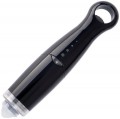Pumping speed
Air pumping speed provided by the vacuum sealer.
The
higher the speed, the less time it will take to operate the device. In addition, "faster" models tend to be more powerful and can deliver deeper vacuums. On the other hand, in normal household use, these points are not critical, and when choosing a "home" sealer, you can not pay much attention to the pumping speed — unless you have to regularly pack large volumes of products, or storage time is crucial.
Suction power
Suction power provided by the vacuum sealer.
This parameter directly characterizes the capabilities of the device to create a vacuum. Suction power is the difference between normal atmospheric pressure (1 bar) and the lowest pressure that this model can create inside the package. For example, a figure of 0.8 bar means that the packer can create a pressure of 1 – 0.8 = 0.2 bar. Accordingly, the higher the number in this point, the more powerful the sealer, the deeper the vacuum it creates.
In general, if the products are packed at home for relatively short storage (or vacuuming is combined with freezing), this indicator can be ignored. But for professional use, high suction power is fundamental.
Power consumption
Rated power consumption of the device. Usually, the characteristics indicate the average power in normal operation; peak values can be much higher, but this mode does not last long.
On the one hand, the efficiency and speed of vacuuming directly depend on the power consumption, on the other hand, the consumption of electricity. And heavy high consumption industrial-grade devices may require a three-phase connection (see "Power supply").
Reusable bags
Durable and long-lasting bags that can be used multiple times for vacuum packaging of products. They are made of reinforced multi-layer materials, usually with a reinforced structure resistant to mechanical damage, temperature fluctuations, and multiple sealings. These bags often feature special valves for vacuuming. After use, the bag can be washed, dried, and reused for storing products. They are particularly convenient for packaging cheese, sausages, vegetables, freezing semi-finished products, and also for marinating.
Reusable bags help save money and reduce waste, but require more careful maintenance: they need to be properly washed, well-dried, and monitored for the condition of the valve and material integrity. Over time, bags wear out, especially with contact with sharp objects or frequent thermal processing, but on average can withstand dozens of use cycles.
Control
Control panel device of the vacuum sealer.
—
Button-based. A classic control system of the vacuum sealer using physical buttons on the body. This solution is considered reliable and intuitively understandable, especially for users who prefer simplicity and tactile feedback. Each function (vacuuming, sealing, stopping, etc.) has a separate button, which simplifies operation and reduces the likelihood of errors.
—
Touch-based. A modern format for controlling the vacuum sealer using a touch-sensitive panel. Instead of physical buttons, flat touch zones with backlight or pictograms are used. This interface makes the device more stylish, easy to clean, and modern in appearance.
Power supply
Power supply used in vacuum sealer.
— Mains (230 V). Powered from a regular household socket of 230 V. This is a convenient and practical option, and therefore it is found in almost all types of packers. The only exceptions are heavy, powerful units designed for 380 V, as well as some manual models that use a battery for added convenience (see below).
—
Battery. Power from a built-in battery is found in manual packers (see “Purpose”). This option is convenient because there is no power cord trailing behind the device when working. On the other hand, cordless models are heavier and more expensive than similar mains-powered devices, and their operating life is limited; when the charge is depleted, you will inevitably have to pause to charge the battery.

